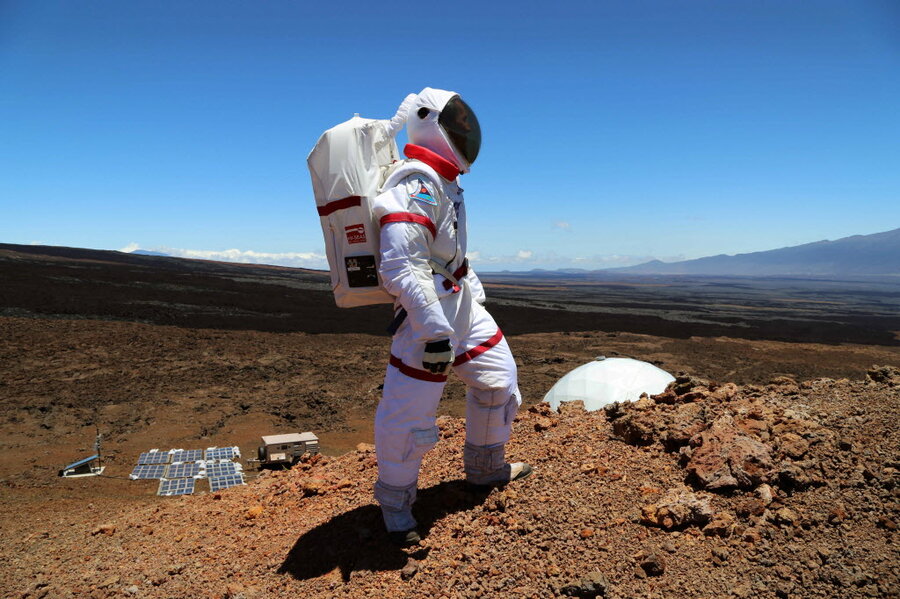Menu on Mars could include sushi, borscht
Loading...
Four months ago, six men and women holed themselves up in a small, white dome on a remote Hawaiian lava field. The people didn’t go out much, and when they did, it was in spacesuits. For the most part, they lived a restrained existence, circulating between the sleeping room and the exercise room – and the kitchen.
The kitchen: that was where all the excitement was happening. This was a NASA-funded experiment to assess what Earthlings might eat if they were to plant a colony on Mars. Out there on the Red Planet, where the mind has little on which to feed besides an expanse of red-tinged rock that meets the horizon, how would astronauts make meals that are not just nutritionally satisfying, but also emotionally so?
Now, the six researchers who stepped out of the kitchen and back into the world on Tuesday have some answers to that question.
Called the Hawaii Space Exploration Analog and Simulation – HI-SEAS – the project was designed to analyze the difference between pre-packaged astronaut food and "home" cooking: is the expense and time-commitment of cooking in space worth the emotional benefit of meals that the astronauts make themselves? The results are expected to help NASA determine where to spend its money in planning a future expedition to Mars.
The project began in December 2012, when the University of Hawaii and Cornell University put out a call for participants who would give up a third of an Earth calendar year – and all the good summer eating expected to come with it – in the name of science. Candidates had to have science degrees but did not need to be chefs. They did, however, “need to at least be eager to eat,” said Kim Binsted, a University of Hawaii at Manoa professor who was involved in overseeing the research.
In April, the crew was moved into their new 993-square-foot home on the black-brown slopes of Mauna Loa, an environment that would replicate the lack of sensory stimulation on Mars, where ecological nothingness might compound an astronauts’ craving for something interesting to eat.
“It’s a very barren mountain field,” said Dr. Binsted. “There’s no vegetation in sight.”
The experiment was organized to have the crew trade off between cooking and non-cooking days every two days. On non-cooking days, the crew ate pre-prepared meals. Some were good, others were not, said Binsted. All the while, the team recorded their assessments of the food, rating such factors as taste and texture.
And then, there were cooking days. For those, the team was provided with non-perishable, preserved, and dehydrated ingredients – the sort that could be ferried all the way to Mars without spoiling. In other words, the researchers were handed a lot of Spam, plus: freeze dried meats and fish; grains like rice and oatmeal; dried fruits and vegetables; lots of nuts and beans and chips; powdered dairy products; baking ingredients; and an impressive roster of spices and condiments.
There was also a stove, an oven, and a microwave. Water was available, but limited.
In short, the kitchen looked a lot like typical one, except everything had been reconfigured into an unrecognizable and less appetizing form. Could those less than palatable ingredients be combined and spiced-up to do what food is supposed to do: send an emotional jolt to the mind, making it brim with memories and feelings?
So, the six people stirred and concocted and invented. Science-minded people outside the little capsule sent in their recipes, and the faux astronauts made them. Spam and its equally (not) delicious companions became lemon dill pasta salad and chili burritos and split pea and spam soup. There was Cajun jambalaya and Arabia Terra Tabouli and sushi rolls. There were spam n’egg sandwiches and pancakes. Birthdays were celebrated, and commemorative cooking ensued. There was a Moroccan beef tangine that went over well – a surprise, since “freeze dried beef doesn’t really capture what people enjoy about beef,” said Binsted.
And for dessert, or a snack, or for whatever or whenever, there was Nutella, the chocolate-hazelnut emotional companion that was rationed like visits to a therapist.
Not that those four-months were one big joyous feast; space cooking, it turns out, does leave something to be desired.
“When they got out, they were so excited to get their hands on fresh fruits and vegetables,” said Binsted. “I think the commander almost cried when he had a tomato again for the first time.”
So far, the results of the experiment are most anecdotal – a good borscht here, some bad tofu "chicken" there – and Binsted said it will be a few months before all of the data is crunched.
Once the results are in, the team hopes they will answer not only the questions of whether, and how, astronauts should cook on Mars, but also other vexing E.T. culinary questions: Why is it that astronauts develop a hankering for ultra-spicy food in space? Is it physiological? Or is it psychological, a product of having been too long in space, where at times the most exciting thing to do is to light a small bonfire on the tongue?
“Astronauts go from eating normally to just pouring tabasco sauce over everything,” said Binsted.
The team has $1.2 million in funding from NASA to further explore the psychological affects of extreme isolation with other people, the sort of closeted togetherness that once made a Jean-Paul Sartre character exclaim, “Hell is other people!” For future experiments, to be conducted over the next three years, the team will select groups of people to live in close quarters for four month, 8-month, and 12-month periods.
“The question is, how do you keep them sane and happy and not killing each other?,” said Binsted.






